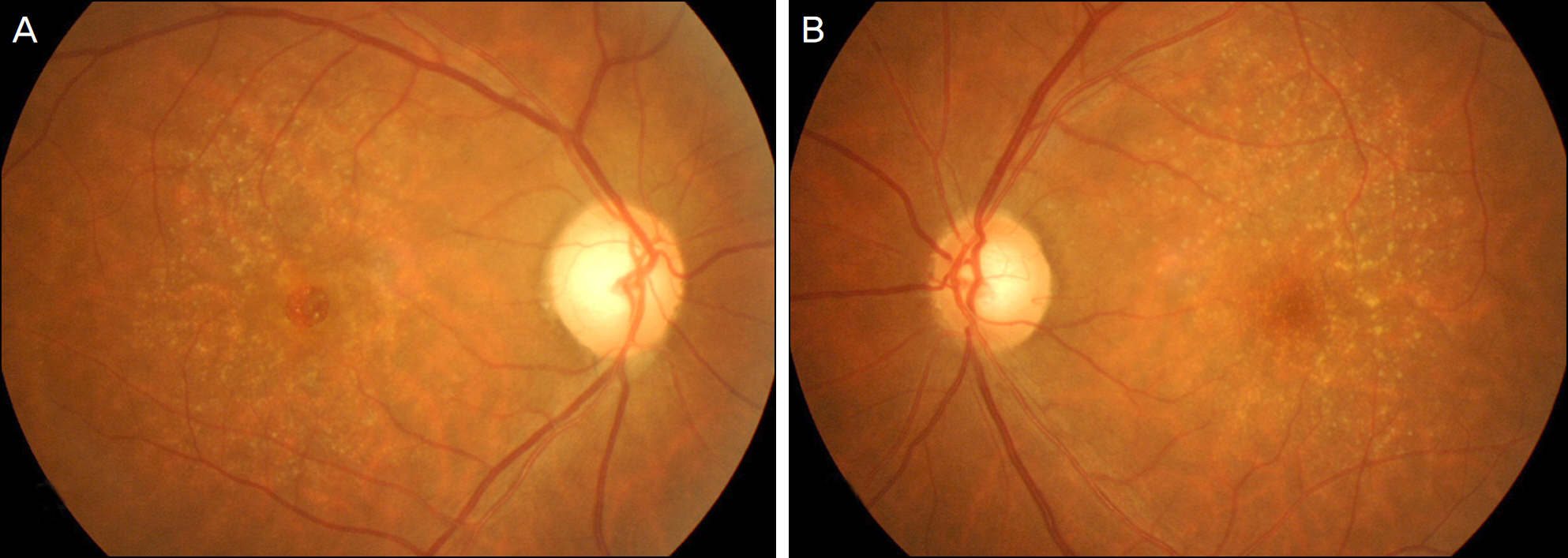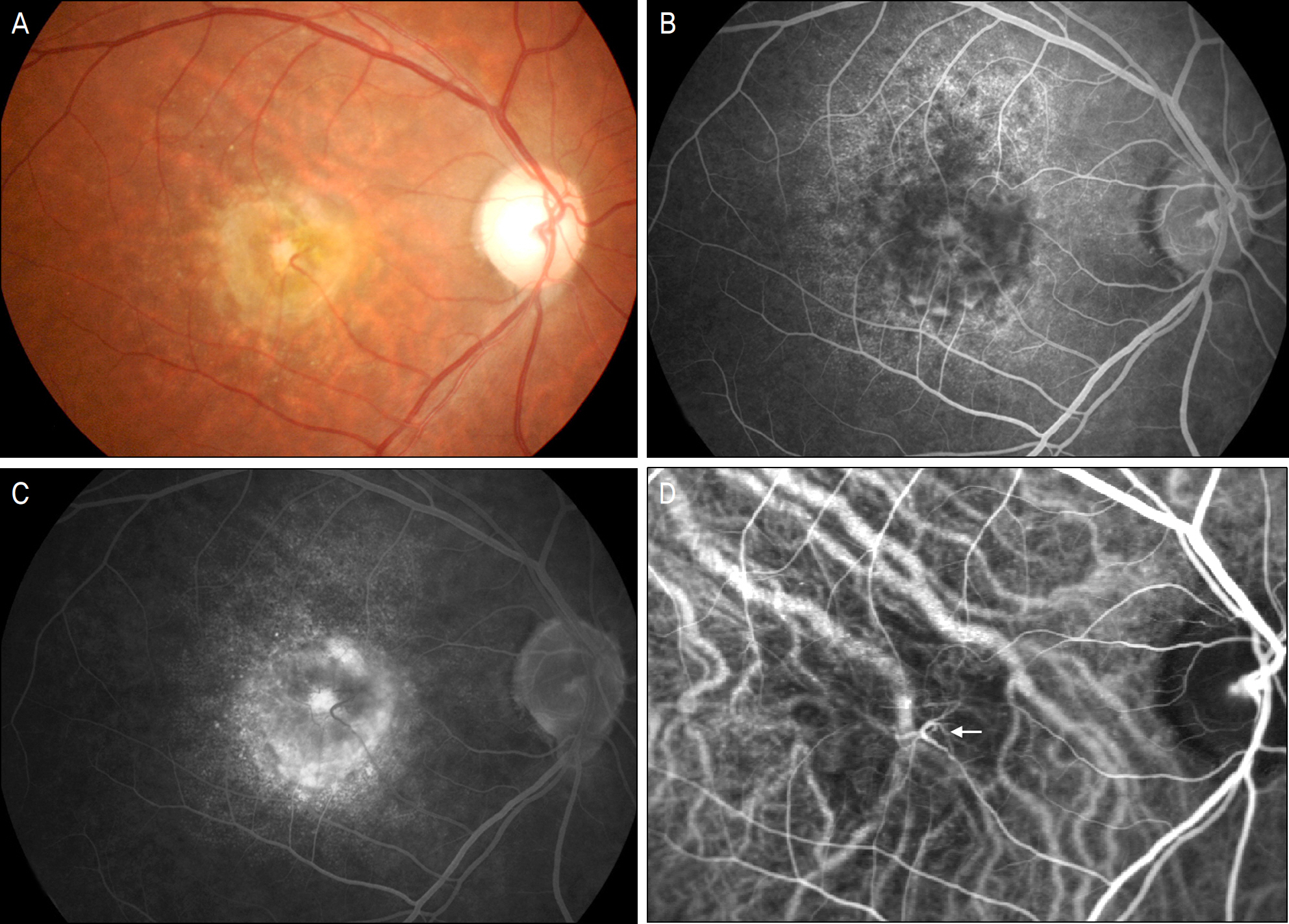J Korean Ophthalmol Soc.
2011 Aug;52(8):1009-1012. 10.3341/jkos.2011.52.8.1009.
A Case of Choroidal Neovascularization Occurring after Macular Hole Surgery
- Affiliations
-
- 1Department of Ophthalmology and Visual Science, The Catholic University of Korea College of Medicine, Seoul, Korea. wklee@catholic.ac.kr
- KMID: 2214783
- DOI: http://doi.org/10.3341/jkos.2011.52.8.1009
Abstract
- PURPOSE
To report a case of choroidal neovascularization after successful macular hole surgery in an eye with macular drusen.
CASE SUMMARY
A 66-year-old woman visited our clinic complaining of decreased visual acuity in her right eye. Fundoscopy showed a full thickness macular hole in the right eye and bilateral scattered drusen. The patient underwent uncomplicated pars plana vitrectomy, internal limiting membrane peeling using triamcinolone, and perfluoropropane (C3F8) gas tamponade. One month after vitrectomy, the macular hole was closed. Twenty-four months following the macular hole surgery, the patient presented with defective vision in the right eye. Fluorescein angiography showed classic subfoveal choroidal neovascularization. Intravitreal bevacizumab was administrated three times in the right eye; however, visual improvement was not observed.
CONCLUSIONS
In eyes with macular hole and drusen, the possibility of choroidal neovascularization developing after macular hole surgery should be considered.
MeSH Terms
Figure
Reference
-
References
1. Kelly NE, Wendel RT. Vitreous surgery for idiopathic macular holes. Results of a pilot study. Arch Ophthalmol. 1991; 109:654–9.
Article2. Lee JE, Oum BS. Macular hole surgery with or without indocyanine green-assisted internal limiting membrane peeling. J Korean Ophthalmol Soc. 2003; 44:2253–9.3. Nam DH, Hwang S, Huh K. Idiopathic macular hole surgery with or without indocyanine green-stained internal limiting membrane peeling. J Korean Ophthalmol Soc. 2004; 45:1086–91.4. Banker AS, Freeman WR, Kim JW, et al. Vision-threatening complications of surgery for full-thickness macular holes. Vitrectomy for Macular Hole Study Group. Ophthalmology. 1997; 104:1442–52. discussion. 1452–3.5. Tabandeh H, Smiddy WE. Choroidal neovascularization following macular hole surgery. Retina. 1999; 19:414–7.
Article6. Tabandeh H, Smiddy WE, Sullivan PM, et al. Characteristics and outcomes of choroidal neovascularization occurring after macular hole surgery. Retina. 2004; 24:714–20.
Article7. Natarajan S, Mehta HB, Mahapatra SK, Sharma S. A rare case of choroidal neovascularization following macular hole surgery. Graefes Arch Clin Exp Ophthalmol. 2006; 244:271–3.
Article8. Berinstein DM, Hassan TS, Williams GA, et al. Surgical repair of full-thickness idiopathic macular holes associated with significant macular drusen. Ophthalmology. 2000; 107:2233–9.
Article
- Full Text Links
- Actions
-
Cited
- CITED
-
- Close
- Share
- Similar articles
-
- Macular Hole Following Intravitreal Ranibizumab Injections for Choroidal Neovascularization
- Macular Hole after Single Intravitreal Injection of Ranibizumab in a Patient with Age-Related Macular Degeneration
- Full-thickness Macular Hole after Intravitreal Aflibercept Injection in a Patient with Wet Age-related Macular Degeneration
- Eccentric Macular Hole Formation After Macular Hole Surgery
- Availability of Optical Coherence Tomography in Diagnosis and Classification of Choroidal Neovascularization



